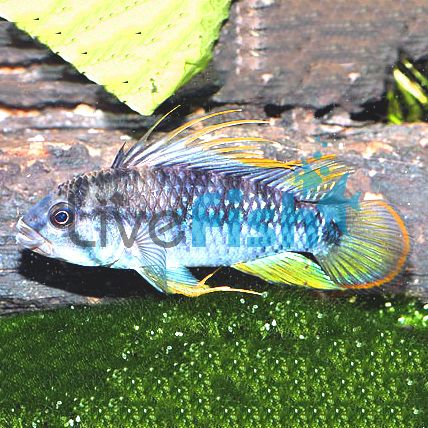Baenschi Inka 50 3cm
The Apistogramma Baenschi is an absolutely phenomenal fish. A vast majority of Apistogramma species available in the aquarium hobby are captive bred but the Baenschi a true wild-caught specimen and only cataloged in 2002! This subspecies being the Inca I have an amazing candy blue belly with flecks of green, yellow, and orange which make it a very different and unique looking Apistogramma in comparison to other readily available species.
- Buy 2 for $50.25 each and save 10%
- Buy 4 for $44.66 each and save 20%
- Buy 8 for $39.08 each and save 30%
The Apistogramma Baenschi is an absolutely phenomenal fish. A vast majority of Apistogramma species available in the aquarium hobby are captive bred but the Baenschi a true wild-caught specimen and only cataloged in 2002! This subspecies being the Inca I have an amazing candy blue belly with flecks of green, yellow, and orange which make it a very different and unique looking Apistogramma in comparison to other readily available species. Apistogramma is a dwarf South American cichlid and these hand caught individuals will be very different when compared to captive-bred Apistogramma. These fish will really be best for aquarists who are wanting a challenge and to really experience the wild and unique behavior of this fish. This fish would be a great long-term addition to a display community aquarium and would be a real eye-catcher to look at. The other interesting aspect about these fish is that distinguishing males and females is far easier as they are very different from one another. males and females differ markedly in color and size. Males have a deep body, large snout with fairly large lips, they also have large rays at the front of the dorsal fin and a blood-red edge to the tail. Females are smaller and less colorful, their dorsal fin is much smaller and they have very dark pelvic fins. o They also have a black spot at the base of the pectorals and this becomes prominent when they are caring for fry. This form of Apistogramma is most likely going to be very shy as it is used to the dangers present in the wild and may take some time to become fully accustomed to an aquarium environment. This dwarf cichlid would do best with other small community fish such as gouramis, tetras, and corydoras. naturally, the wild Apistogramma Baenschi habitat in South America.
Tank Recommendations for your Apistogramma Baenschi
The Apistogramma Baenschi only needs a tank of around 20 gallons (75 liters) as they are a small growing fish. This makes them great for nano community aquariums or to just show off a breeding pair of Apistogramma. A sand substrate is advisable as these cichlids actively will sift through the sand looking for food. They will also appreciate hiding areas around small pieces of driftwood, rock caves and they will love a densely planted aquarium as well. This wild-caught species will really prefer dim lighting which best replicates its wild environment.
Suitable Tank Buddies
The Apistogramma Baenschi is quite peaceful with aggression only ever coming out during breeding. With adequate space, these fish will get along with a wide range of community fish.
Usually Compatible
Tetras, gouramis, corydoras, angelfish, cherry barbs, and common community fish species.
Sometime Compatible
Other Apistogramma species and dwarf cichlids such as rams and large peaceful cichlids such as uaru or Severums which might outcompete for food.
Rarely Compatible
Shrimp and large aggressive species such as African cichlids, Oscars and Jaguar cichlids.
Feeding your Apistogramma Baenschi
Being that these Apistogramma are wild-caught they may take a little bit to accustom themselves to foods such as pellet or flake. It is best to start feeding them with nano live foods such as blackworms, micro-worms and then wean them onto frozen foods. then an attempt can be made to feed prepared foods such as pellets or flake. Feeding should occur once a day and it is best to do so when the lights are on during the day.
| Scientific Name | Apistogramma Baenschi |
|---|---|
| Care Level | Moderate |
| Common Names | Apistogramma Baenschi, Apistogramma Inca |
| Diet | Omnivore |
| Fish Family | Cichlidae |
| Lifespan (years) | 10 |
| Max. Length (cm) | 6 8 |
| Min. Tank Volume (l) | 67 Litres |
| Origin | South America |
| Sociability | Peaceful |
| Water Conditions | 24-26° C, pH 5.0-7.0 |




